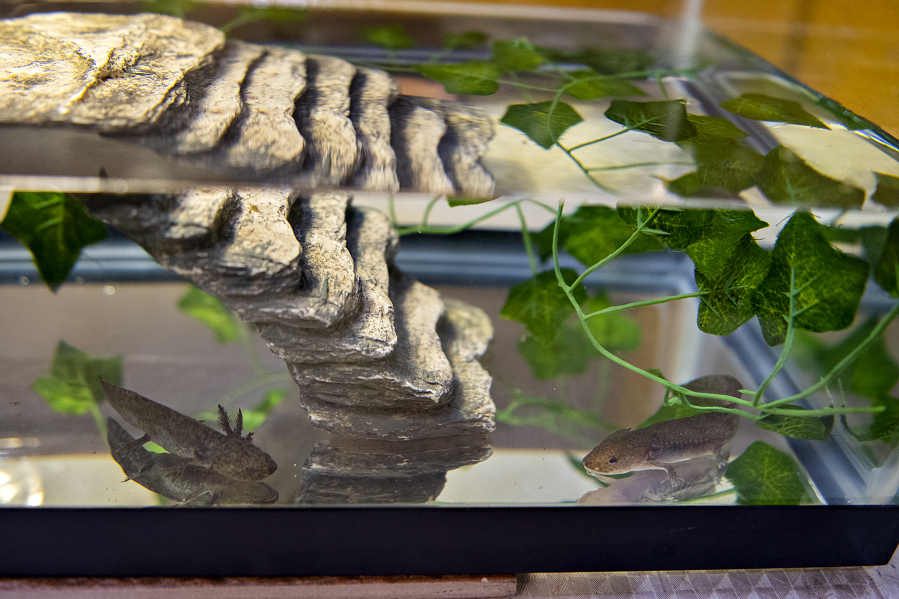What’s native only to Mexico’s Lake Xochimilco, comes in rainbow colors and has a permanently thrilled expression? An axolotl, of course! It’s a species of salamander with distinctive exterior gills that form a ruffled fan around its neck. The axolotl (pronounced “AX-uh-lot-ull”) is named after Xolotl, the Aztec god of fire and lighting who sometimes appears in the form of a salamander. In spite of their fierce namesake, axolotls are positively adorable, with upturned mouths and button eyes that invite you to smile back and say “I like you too, little buddy!”
Although wild axolotls are critically endangered — varying estimates put the wild axolotl population anywhere from 50 to 1,200 — they are proliferating in captivity, where their popularity as household pets has recently skyrocketed (although they’re illegal to own in California, Maine, New Jersey and Virginia).
One recent survey from allaboutcats.com lists axolotls as the country’s second most-wanted pet, after dogs. Younger folks may be familiar with axolotls from the video game Minecraft, which introduced axolotls into its digital world last year. Once you learn to recognize that friendly amphibian face, axolotls start popping up everywhere, from keychains and punny T-shirts (“I axolotl questions”) to crocheted or sculpted axolotls on etsy.com.
Alley Cat Pet Center in Vancouver Mall was well ahead of the trend and has been selling axolotls for “well over two decades,” store manager Angela Clifton said.
“They’re so easy to breed and so interesting to people.”
Clifton said she’s seen a definite uptick in parents and grandparents purchasing axolotls ($39.99 each) for their children or grandchildren.
“Part of the popularity with kids is you have a lot more social media that’s dedicated to axolotls,” she said. “People will have Facebook pages about axolotls and a lot of animal-related YouTubers will feature axolotls on their YouTube channels and programs. Kids seem to glom on to that information and the cuteness.”
One of the axolotl’s most unusual features is its ability to regenerate nearly any body part, “pretty much anything up to and including the front portion of their brain,” Clifton said. “Limbs, gills, tails — you can watch it happen. It’s not an extremely slow process. It’s actually pretty quick. They’ll lose a foot and you’ll start to see regeneration in a week.”
She described how scientists use green fluorescent protein to study the regenerative process. The protein is introduced into the DNA of laboratory axolotls, Clifton said, causing them to glow when placed under a black light.
This green fluorescence is now present in many pet-trade axolotls, she said, though it’s hard to detect anything but “a wisp of a difference” with the naked eye.
Striking color variations are another appealing aspect of these sought-after salamanders. Axolotls have four pigmentation genes that combine to create a spectrum of mesmerizing hues and patterns, from the gold-speckled olive and tan of wild axolotls to captive-bred leucistic, or “lucy,” axolotls with almost no pigmentation, sporting pale pink skin, black eyes and salmon-colored gills. Axolotl colors have evocative names like firefly, chimera and enigma. High iridophore (a reflective pigment) axolotls seem dipped in gold, copper axolotls shine like pennies and gray-spotted silver dalmatians move like lavender shadows around the tank.
Axolotls are neotenic, Clifton said, which means that they retain their adolescent form into adulthood. While other salamanders metamorphose into land creatures, axolotls spend their entire lives under water and never lose their feathery gills, finned tails or overlarge heads. These physical characteristics enhance the axolotl’s charm, giving it a cuddly appearance that makes you want to give it a hug — but please don’t, Clifton said.
“Handling them can be damaging to them because the natural oils on our skin can damage their slime coating, just like you wouldn’t want to handle a fish,” Clifton said. “You could be introducing bacteria to their skin or to the tank water if you’ve got anything on your hands.”
This doesn’t mean that you can never touch your axolotl. Just do it with scrupulously clean hands and only underwater. Axolotls do have lungs, but they get oxygen primarily through their gills and can only breathe for a very short time out of water, Clifton said.
“A lot of people have their axolotls trained to where they can put their hand in the water and the axolotls will swim up and sit in their hand,” Clifton said. “You can actually get them to do a lot for food. They know who you are. They know you’re the bearer of treats.”
Treats include bloodworms, tubifex worms, brine shrimp or special pellets. They love earthworms, but make sure they’re from a supplier because worms from the yard might contain parasites harmful to your frond-headed friend.
Though axolotls have permeable skin and soft, cartilaginous bones, they’re pretty hardy, Clifton said. They’re easier to care for than many fish, she said, but they do require specific conditions. (For thorough information about axolotl care, try axolotlcentral.com.)
They like it cooler than most aquarium fish, Clifton said, between 57 and 68 degrees, with a pH between 6.5 and 7.5. Tap water is fine for axolotls, but it must be treated with a conditioner that removes chlorine and chloramine. Clifton also suggests a smooth tank bottom because axolotls eat by sucking things into their mouths, so it’s easy for them to ingest gravel. Sand is OK, she said, “but sand is harder to clean. When you’re having to change the axolotl tank water once a week, it’s kind of a pain.”
Axolotls may be adorable but that doesn’t mean they don’t poop. Before putting your axolotl in its new tank, the water must be “cycled,” or dosed with a small amount of ammonia to establish beneficial, nitrite-consuming bacteria in your aquarium filter, a process that can take up to two weeks.
Though these good bacteria will help consume the waste your axolotl produces, the tank should still be cleaned weekly. Clifton also noted that axolotls, especially smaller ones, can be distressed by strong currents. Clifton suggested putting things in the tank to reduce the flow of water through your filter. The objects will also give bashful axolotls some sheltered spaces where they can relax.
“They like caves, things that they can go under,” Clifton said. “Floating plants, whether they’re fake or live, are always good. They’re fairly shy creatures so providing them someplace to hide reduces their stress level.”
If conditions are right, a thriving pet axolotl can grow to about 9 inches, Clifton said, larger than most native salamanders, with the exception of the Pacific giant salamander. You could become the owner of a happy, hefty worm-eating machine.
“It will have some decent body weight on it. Some get up to 12 inches,” Clifton said. “A foot-size smiling salamander is something to see.”




